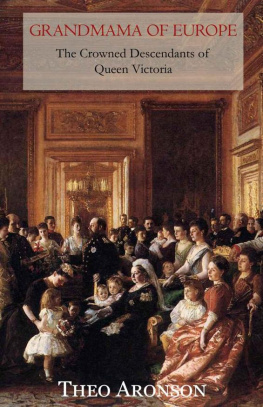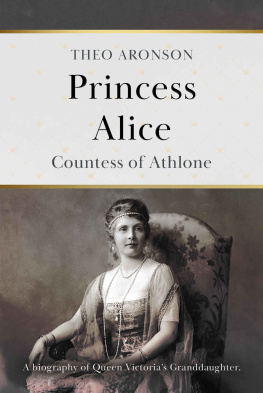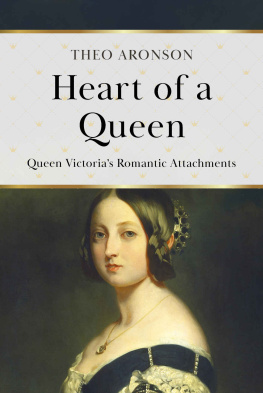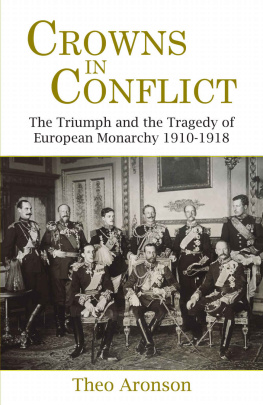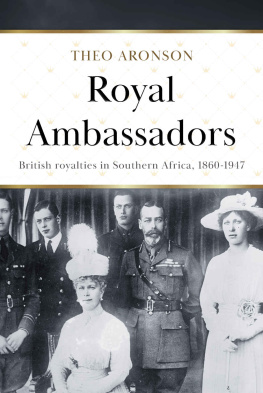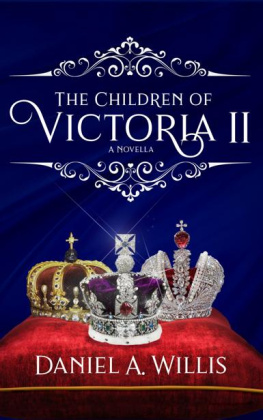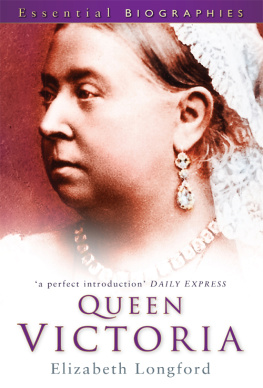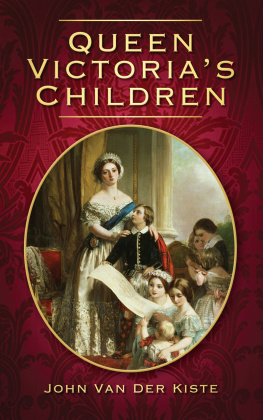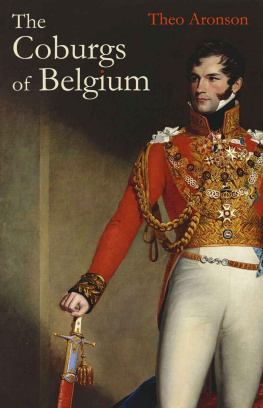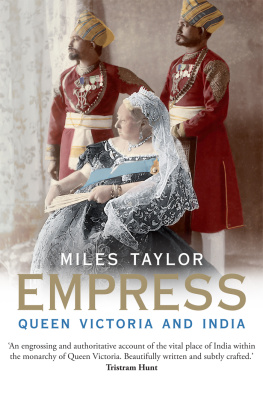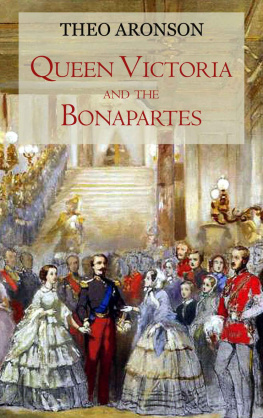Grandmama of Europe
The Crowned Descendants of Queen Victoria
Theo Aronson
All Rights Reserved
This edition published in 2014 by:
Thistle Publishing
36 Great Smith Street
London
SW1P 3BU
www.thistlepublishing.co.uk
ISBN-13: 978-1910198049
Contents
Illustrations
Between pages 148 and 149
Queen Victoria at the age of seventy-five
Queen Victoria's eldest daughter, Vicky
Queen Victoria photographed for her Golden Jubilee, with the Prince and Princess of Wales
Fritz, later Kaiser Frederick III, Queen Victoria's son-in-law
The Grandmama of Europe, surrounded by her family, at the time of her Golden Jubilee. A painting by Tuxen
By gracious permission of H.M. The Queen
The Wales family in 1889
Radio Times Hulton Picture Library
Queen Victoria with her grandson Willie, German Crown Prince, her daughter Vicky, the German Empress, Crown Princess Dona, and three of Vicky's daughters
Four generations: Queen Victoria holds Prince Edward (later King Edward VIII). Behind stand Bertie, Prince of Wales, and Georgie, Duke of York
The wedding of Constantine and Sophie in Athens
Sophie, daughter of the Empress Frederick, and Crown Prince Constantine, in 1889
Queen Victoria's granddaughter Alexandra ('Alicky'), Empress of Russia
Queen Victoria with the Prince of Wales, Tsar Nicholas II, the Tsaritsa Alexandra and their baby, the Grand Duchess Olga
Crown Prince Ferdinand of Romania holding his eldest son, Carol, later King Carol II
Marie of Romania in 1907
King Alfonso XIII and Queen Ena of Spain, in the early days of their marriage
King Alfonso XIII and Queen Ena on the way back from their wedding, seconds before the bomb was thrown at their carriage
The Empress Alexandra of Russia
Marie of Romania at her coronation in 1922
The funeral procession of Edward VIII, attended by nine monarchs Illustrated London News
Princess Maud of Wales and Prince Charles of Denmark, later King and Queen of Norway, at the time of their marriage
The first coronation ever photographed; the enthronement of King Haakon and Queen Maud, June 1906
Illustrated London News
King Alexander of Yugoslavia
Queen Marie of Yugoslavia with her sons Peter, Andrej and Tomislav
The scene after the assassination of King Alexander of Yugoslavia in Marseilles, 1934
Princess Sophie of Greece at the time of her conversion to the Greek Orthodox faith
'Mignon', daughter of Queen Marie of Romania and wife of King Alexander, holding her eldest son Peter
Princess Louise of Battenberg, later Queen of Sweden, by Philip Laszlo
Queen Ena of Spain, by Philip Laszlo
Crown Prince Frederick of Denmark and Princess Ingrid of Sweden after their marriage, 1935
King Frederick IX and Queen Ingrid of Denmark later in life
By courtesy of the Danish Embassy
King Gustav VI Adolf of Sweden
By courtesy of the Swedish Embassy
Queen Louise of Sweden
By courtesy of the Swedish Embassy
Author's Note
The direct descendants of Queen Victoria occupy, or have occupied, ten European thrones. It is with this dynastic expansion that this book is concerned. However, in order to accommodate, and make intelligible, so immense a subject as the Queen's crowned descendants, I have found it necessary to set myself certain limits. The study is confined to those of the Queen's children, grandchildren or great-grandchildren who first occupied the various European thrones, and not with their descendants. I therefore deal with Queen Victoria's son Bertie, who became King Edward VII but not with his son, who became King George V; and with the Queen's daughter Vicky who as the wife of the German Emperor Frederick III became German Empress, but not with Vicky's son Kaiser Wilhelm II. I do, however, deal with Vicky's daughter Sophie, who married the future King of the Hellenes; for she, as Queen Victoria's granddaughter, was the first of Victoria's direct descendants to become a queen in Greece. Thus, with the exception of King Edward VII, this book is concerned with the various British or half-British princesses who became the queens and empresses of Europe.
Secondly, I have confined myself, very largely, to the personal lives of the characters concerned; this is a domestic history, not a political one. The focus throughout is on the royal courts; the political, economic and military events of the period are relegated to the background. Only when a subject such as Vicky, the German Empress, or Alicky, the Tsaritsa is closely involved in the political life of the country, are politics dealt with in any detail; otherwise they are simply mentioned en passant. This is a book about people. It is biography, rather than history.
I must thank Her Majesty Queen Elizabeth II by whose gracious permission certain extracts from the Journals of Queen Victoria are here published for the first time. For arranging this, I am indebted to Sir Michael Adeane, Her Majesty the Queen's Private Secretary and Keeper of the Archives, and Mr Robert Mackworth-Young, Librarian at Windsor Castle. I am grateful for the help I have received from Dr Anton Ritthaler of the Hausarchiv, Burg Hohenzollern, Munich, Dr Branig of the Geheimes Staatsarchiv, Berlin, and Don J. Almudevar of the Biblioteca Nacional, Madrid. I must thank also the staffs of the British Museum, the Spanish Institute Library and the Hispanic Council Library, London; the Library of Congress, Washington; the Biblioteca Nacional, Madrid; and the Danish Ministry of Foreign Affairs, Copenhagen.
I owe a special word of thanks to Miss Myra Conradie, not only for drawing up the magnificent genealogical table from which I have worked (and of which only a simplified version appears in this book) but for helpful advice during the planning stages of this study. For information, material, advice and help, I am indebted to Don Ernesto La Orden, Don Manuel Garcia-Miranda, Dr Klaus Schmidt, Mr Anton Reinhardt, Mr P. Skovgaard Andersen, Mr Lars Jensen, Mr Christopher Lavrano, Mr Keith Killby, Mr Andre Bothner, Mrs Alma Holtzhausen, Mrs Dorothy Caine, Mrs Ilse Rooseboom, Miss Ann Seeliger and Miss Norah Henshilwood.
My chief thanks, however, are to Mr Brian Roberts whose assistance, encouragement and expert advice have been invaluable.
Four recently published books which have proved especially useful and to whose authors I am deeply indebted are Nicholas and Alexandra by Robert K. Massie (Gollancz), Queen Mary by James Pope-Hennessy (Allen & Unwin), King Edward the Seventh by Philip Magnus (John Murray) and Louise Mountbatten, Queen of Sweden by Margit Fjellman (Allen & Unwin). I should also like to thank the publishers of the following books for permission to quote copyright material: Letters of the Empress Frederick, edited by Sir Frederick Ponsonby and Recollections of Three Reigns, by Sir Frederick Ponsonby (Macmillan & Co Ltd, London and Basingstoke); The Empress Frederick Writes to Sophie, edited by Arthur Gould Lee (Faber & Faber); The Letters of Queen Victoria, 2nd series, edited by G. E. Buckle (John Murray).
1973
PROLOGUE
Golden Jubilee
Summer 1887
1
'The day has come,' wrote Queen Victoria on the morning of 20 June 1887, 'and I am alone....'
By 'alone' the Queen meant that the Prince Consort, dead these twenty-five years, was not by her side to celebrate her Golden Jubilee. She could hardly have meant anything else. Buckingham Palace was crammed with royal guests, the majority of whom were closely related to the Queen. At every turn she could come up against a son, a daughter, a grandson, a granddaughter, a first or a second cousin. Although the Queen's husband might have been absent, their family, which she admitted was 'legion', was very much in evidence.

